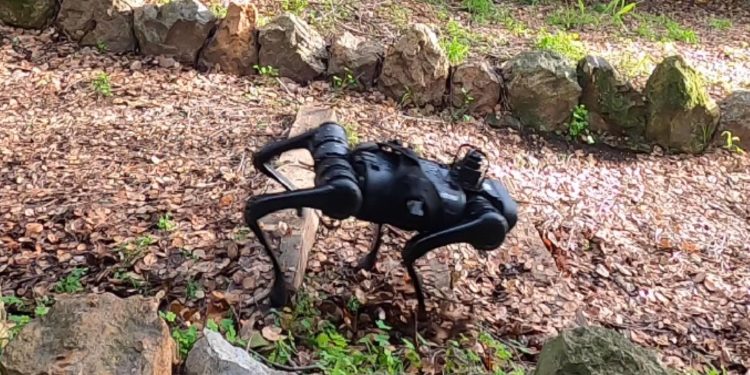| AI Improves Robotic Performance in DARPA’s Machine Common Sense Program
人工智能在DARPA机器常识项目中提高机器人性能 Date:2022-06-25 Source:DefenceTalk By:Technology News Viewed: |
by DefenceTalk June 23, 2022 in Technology News
由DefenceTalk于2022年6月23日在《技术新闻》上发布

Researchers with DARPA’s Machine Common Sense (MCS) program demonstrated a series of improvements to robotic system performance over the course of multiple experiments. Just as infants must learn from experience, MCS seeks to construct computational models that mimic the core domains of child cognition for objects (intuitive physics), agents (intentional actors), and places (spatial navigation).
美国防高级研究计划局(DARPA)机器常识(MCS)项目的研究人员在多个实验过程中展示了机器人系统性能的一系列改进。正如婴儿必须从经验中学习一样,MCS寻求构建模拟儿童对对象(直观物理)、代理(有意行动者)和位置(空间导航)认知核心领域的计算模型。
Using only simulated training, recent MCS experiments demonstrated advancements in systems’ abilities – ranging from understanding how to grasp objects and adapting to obstacles, to changing speed/gait for various goals.
仅使用模拟训练,最近的MCS实验证明了系统能力的进步,从理解如何抓住物体和适应障碍,到为各种目标改变速度/步态。
“These experiments are important milestones that get us closer to building and fielding robust robotic systems with generalized movement capabilities,” said Dr. Howard Shrobe, MCS program manager in DARPA’s Information Innovation Office. “The prototype systems don’t need large sensor suites to deal with unexpected situations likely to occur in the real world.”
DARPA信息创新办公室MCS项目经理霍华德·肖伯(Howard Shrobe)博士说:“这些实验是重要的里程碑,使我们更接近于构建和部署具有通用运动能力的强大机器人系统。” “原型系统不需要大型传感器套件来处理现实世界中可能发生的意外情况。”
Rapidly Adapting to Changing Terrain
快速适应不断变化的地形
In one experiment, researchers at the University of California, Berkeley developed a rapid motor adaption (RMA) algorithm that allows quadruped robots to adapt rapidly to changing terrain. Using the RMA algorithm and proprioceptive feedback (the sense of self-movement and body position), the robots successfully navigated through a range of both real-world and simulated terrain.
在一项实验中,加州大学伯克利分校的研究人员开发了一种快速运动适应(RMA)算法,使四足机器人能够快速适应不断变化的地形。使用RMA算法和本体感觉反馈(自我运动感和身体位置感),机器人成功地在真实世界和模拟地形范围内导航。
The algorithm is trained completely in simulation without using any domain knowledge-like reference trajectories or predefined foot trajectory generators and is deployed without any fine-tuning. Real-time terrain adaption is essential for quadruped robots to help military units with load carrying and sensing.
该算法完全在模拟中进行训练,无需使用任何领域知识,如参考轨迹或预定义的足部轨迹生成器,并且无需任何微调即可部署。实时地形适应对于四足机器人帮助军事单位进行承载和传感至关重要。
Carrying Dynamic Loads
承载动态载荷
Oregon State researchers demonstrated the ability for a bipedal robot to learn how to carry dynamic loads with only proprioceptive feedback. The robot, known as Cassie, learned commonsense behaviors in a simulated-to-real learning environment. Cassie adapted its gait to account for changes in load dynamics, such as sloshing liquids or balancing weights. After training in simulation, Cassie was able to walk on a treadmill for several minutes with four different types of dynamic loads. In contrast, before the learned commonsense training, Cassie fell immediately.
俄勒冈州立大学的研究人员展示了双足机器人学习如何仅通过本体感受反馈来承载动态负载的能力。这个名为卡西(Cassie)的机器人在模拟到真实的学习环境中学习常识行为。卡西调整其步态以适应负载动态的变化,例如晃动液体或平衡重物。经过模拟训练后,卡西能够在四种不同类型的动态负载下在跑步机上行走几分钟。相比之下,在学习常识训练之前,卡西立即倒下了。
Understanding How to Grasp Objects
了解如何抓取对象
In natural environments, humans encounter a vast variety of possible tools, tool variations, and objects. This variety presents a challenge for robots. They must foresee all possibilities to function, which is why it’s important that they’re equipped with a general grasping capability rather than a specialized capability, for a predefined set of objects.
在自然环境中,人类会遇到各种可能的工具、工具变体和对象。这种多样性给机器人带来了挑战。它们必须预见到所有可能的功能,这就是为什么对于一组预定义的对象,它们必须具备一般的抓取能力,而不是专门的能力。
University of Utah researchers as part of the Oregon State University MCS team developed an active, grasp-learning algorithm that allows robots with multi-fingered hands to dexterously grasp previously unseen objects when trained entirely in simulation.
作为俄勒冈州立大学MCS团队的一员,犹他大学的研究人员开发了一种主动的抓取学习算法,该算法允许多指手机器人在完全接受模拟训练时灵巧地抓取以前没见过的物体。
The new approach enabled the robot to grasp with higher than 93% real-world success on novel objects compared to 78% of existing passive learning approaches.
与现有被动学习方法的78%相比,新方法使机器人能够以高于93%的真实世界成功率抓取新物体。
Additional Research
额外研究
Another technical area within MCS seeks to develop computational tools that learn from reading the web, like a research librarian, to construct a commonsense knowledge repository capable of answering natural language and image-based questions about commonsense phenomena.
MCS中的另一个技术领域旨在开发从阅读网络中学习的计算工具,例如研究图书馆员,以构建能够回答自然语言和基于图像的关于常识现象的问题的常识知识库。
MCS researchers from the University of Washington and two teams from the University of Southern California, Information Sciences Institute are currently using a variety of approaches, including hyperbolic learning. This technique learns the commonsense structure of human behavior and physics from large collections of videos to forecast human actions up to 30 seconds in the future.
华盛顿大学的MCS研究人员和南加州大学信息科学研究所的两个团队目前正在使用多种方法,包括双曲线学习。该技术从大量视频中学习人类行为和物理的常识结构,以预测未来长达30秒的人类行为。
The researchers are also building a scalable, machine-authored, symbolic knowledge base that will provide a higher quality, larger, and more diverse representation of the world.
研究人员还在构建一个可扩展的、机器编写的符号知识库,它将提供更高质量、更大、更多样化的世界表示。
“By focusing on commonsense, we are creating the possibility for systems to have the flexibility of human learning and the breadth of human knowledge,” Shrobe said. “Fusing this knowledge with advanced robotics could result in highly capable, mission-critical systems that humans will want to have as partners.”
“通过关注常识,我们正在为系统创造具有人类学习灵活性和人类知识广度的可能性,”肖伯说。 “将这些知识与先进的机器人技术相结合,可能会产生人类希望拥有的功能强大、关键任务系统作为合作伙伴。”
上一篇:Antennas:The hard physics challenge for Space Force ‘hybrid’ SATCOM plan 下一篇:‘Bullet made out of light’: Army to field first Stryker-mounted combat laser in next 45 days
| Here are the bunker-buster bombs used on Iran’s Fordo nuclear facility
这是用于伊朗福尔多核设施的碉堡炸弹 |
| In inserting itself into Israel’s war against Iran, the U.S. unleashed its massive “bunker-buster” bombs on Iran’s Fordo fuel enrichment plant.... [2025-07-05] |
| Ukraine's new F-16s receive secret US electronic warfare systems to counter Russi
乌克兰新获的F-16战斗机接收了美国的秘密电子战系统,以应对俄罗斯的威胁 |
| The electronic warfare systems on these Ukrainian F-16s were not part of the U.S. inventory, presenting a significant challenge for the 68th Electronic Warfare Squadron.... [2024-08-28] |
| No U.S. Navy Aircraft Carriers Deployed In The Pacific
美国海军没有在太平洋部署航母 |
| The U.S. Navy is facing a shortfall of deployed carriers in the Pacific as the buildup in the Middle East continues. ... [2024-08-27] |
| France and Serbia Successfully Conclude Negotiations for Sale of 12 Rafale Fighte
法国和塞尔维亚成功完成12架阵风战斗机的销售谈判 |
| Dassault Aviation has successfully concluded negotiations for the sale of 12 Rafale fighter jets to Serbia, marking a significant advancement in bilateral relations between France and Serbia, as reported by LaTribune.... [2024-08-27] |
